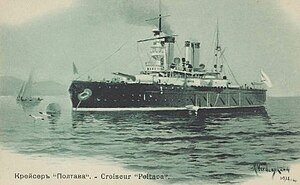Petropavlovsk-class battleship

A postcard showing Poltava at anchor
|
|
| Class overview | |
|---|---|
| Operators: |
|
| Preceded by: | Imperator Aleksandr II class |
| Succeeded by: | Tri Sviatitelia |
| Built: | 1892–1898 |
| In commission: | 1897–1923 |
| Completed: | 3 |
| Lost: | 2 |
| Scrapped: | 1 |
| General characteristics | |
| Type: | Pre-dreadnought battleship |
| Displacement: | 11,354–11,842 long tons (11,536–12,032 t) |
| Length: | 376 ft (114.6 m) |
| Beam: | 70 ft (21.3 m) |
| Draught: | 28 ft 3 in (8.6 m) |
| Installed power: | |
| Propulsion: | 2 shafts, 2 vertical triple-expansion steam engines |
| Speed: | 16 knots (30 km/h; 18 mph) |
| Range: | 3,750 nmi (6,940 km; 4,320 mi) |
| Complement: | 662 |
| Armament: |
|
| Armor: |
|
The Petropavlovsk class, sometimes referred to as the Poltava class, was a class of three pre-dreadnought battleships built for the Imperial Russian Navy during the 1890s. They were transferred to the Pacific Squadron upon completion and based at Port Arthur before the start of the Russo-Japanese War of 1904–1905. All three ships participated in the Battle of Port Arthur on the second day of the war. Petropavlovsk sank two months after the war began after striking one or more mines laid by the Japanese. The remaining two ships participated in the Battle of the Yellow Sea in August 1904 and were sunk or scuttled during the final stages of the Siege of Port Arthur.
Poltava was salvaged after the Japanese captured Port Arthur and incorporated into the Imperial Japanese Navy. The ship, renamed Tango in Japanese service, participated in the Battle of Tsingtao in late 1914, during World War I. She was sold back to the Russians in 1916 and renamed Chesma as her original name was in use by another battleship. The ship became the flagship of the Russian Arctic Flotilla in 1917 and her crew supported the Bolsheviks later that year. She was seized by the British in early 1918 when they intervened in the Russian Civil War, abandoned by them when they withdrew and scrapped by the Soviets in 1924.
...
Wikipedia
